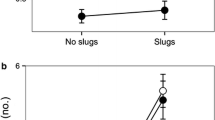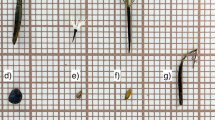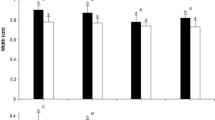Abstract
In beech-dominated forests in Central Europe, many spring geophytes show adaptations to seed dispersal by ants (myrmecochory). Ants, however, can be rare in such moist forests. Motivated by observations of slug feeding on seeds we investigated the seed consumption of two plant species, Anemone nemorosa and Asarum europaeum, by slugs, in a series of experiments. In a seed predation experiment in a beech forest, we found that seed removal was strongly reduced when gastropods were excluded from the seed depots. The contribution of insects, including ants, and rodents to seed removal was relatively less but differed between May and July. In the laboratory, slug species, in particular Arion sp., consumed seeds of both plant species. Slugs either consumed the elaiosomes of seeds or swallowed seeds intact. Swallowed seeds were defecated undamaged and germinated as well as control seeds when buried overwinter, indicating the potential for seed dispersal by slugs. We also recovered seeds of myrmecochores in the faeces of several slugs caught in forests. In a slug release experiment in the forest, slugs moved up to 14.6 m (mean 4.4 m) in 15 h, which is the median gut passage time of seeds based on measurements made in the laboratory. We also found that when slug-defecated seeds were offered to rodents, these were less attractive than control seeds, suggesting that passage through the slug gut reduces seed predation risk. Our results demonstrate that slugs are significant consumers of elaiosomes or entire seeds of ant-dispersed plants and that they can function as seed dispersers of these plants.




Similar content being viewed by others
References
Anderson CJ, MacMahon JA (2001) Granivores, exclosures, and seed banks: harvester ants and rodents in sagebrush-steppe. J Arid Environ 49:343–355
Anu A, Sabu TK (2007) Biodiversity analysis of forest litter ant assemblages in the Wayanad region of Western Ghats using taxonomic and conventional diversity measures. J Insect Sci 7.06 (http://insectscience.org/7.06)
Bless R (1977) Seasonal changes of some gastropod species in Kottenforst-Ville-Park. Anz Schadlingskd Pfl 50:65–68
Bogon K (1990) Landschnecken: Biologie–Ökologie–Biotopschutz. Natur-Verl, Augsburg
Bojnansky V, Fargasova A (2007) Atlas of seeds and fruits of Central and East-European flora. The Carpathian Mountains Region. Springer SBS, Dordrecht
Bond WJ, Breytenbach GJ (1985) Ants, rodents and seed predation in Proteaceae. S Afr J Zool 20:150–154
Boulay R, Coll-Toledano J, Cerda X (2006) Geographic variations in Helleborus foetidus elaiosome lipid composition: implications for dispersal by ants. Chemoecology 16:1–7
Boulay R, Coll-Toledano J, Manzaneda AJ, Cerda X (2007) Geographic variations in seed dispersal by ants: are plant and seed traits decisive? Naturwissenschaften 94:242–246
Boyd RS (2001) Ecological benefits of myrmecochory for the endangered chaparral shrub Fremontodendron decumbens (Sterculiaceae). Am J Bot 88:234–241
Bresinsky A (1963) Bau, Entwicklungsgeschichte und Inhaltsstoffe der Elaiosomen. Bibl Bot 126:1–54
Canullo R (1985) La recolonisation des champs abandonnés par l’espèce forestière Anemone nemorosa L.: II–Rythme saisonnier, reproduction et potentialité générative des populations de forêt, de broussailles et de prairie. G Bot Ital 119(5-6):261–289
Cardina J, Norquay HM, Stinner BR, McCartney DA (1996) Postdispersal predation of velvetleaf (Abutilon theophrasti) seeds. Weed Sci 44:534–539
Corbet G, Ovenden D (1980) The mammals of Britain and Europe. William Collins, London
Culver DC, Beattie AJ (1978) Myrmecochory in Viola: dynamics of seed–ant interactions in some West-Virginia species. J Ecol 66:53–72
Edwards W, Dunlop M, Rodgerson L (2006) The evolution of rewards: seed dispersal, seed size and elaiosome size. J Ecol 94:687–694
Ehrmann P (1956) Mollusca. In: Brohmer P, Ehrmann P, Ulmer G (eds) Die Tierwelt Mitteleuropas. 2. Band: Weichtiere-Krebstiere-Tausendfüssler. Quelle und Meyer, Leipzig, pp 1–264
Falkner G (1989) Binnenmollusken. In: Steinbach G (ed) Weichtiere. Mosaik Verlag, Munich, pp 112–280
Fischer RC, Richter A, Hadacek F, Mayer V (2008) Chemical differences between seeds and elaiosomes indicate an adaptation to nutritional needs of ants. Oecologia 155:539–547
Fokuhl G, Heinze J, Poschlod P (2007) Colony growth in Myrmica rubra with supplementation of myrmecochorous seeds. Ecol Res 22:845–847
Frömmig E (1950) Untersuchungen über die Farbvarietäten und die Ernährung der Nacktschnecke Arion empiricorum. Arch Moll 79:117–126
Gervais JA, Traveset A, Willson MF (1998) The potential for seed dispersal by the banana slug (Ariolimax columbianus). Am Midl Nat 140:103–110
Giladi I (2006) Choosing benefits or partners: a review of the evidence for the evolution of myrmecochory. Oikos 112:481–492
Gomez C, Espadaler X (1998) Myrmecochorous dispersal distances: a world survey. J Biogeogr 25:573–580
Gorb E, Gorb S (2003) Seed dispersal by ants in a deciduous forest ecosystem. Kluwer, Dordrecht
Grimm B (1996) A new method for individually marking slugs (Arion lusitanicus (Mabille)) by magnetic transponders. J Molluscan Stud 62:477–482
Grimm B, Schaumberger K (2002) Daily activity of the pest slug Arion lusitanicus under laboratory conditions. Ann Appl Biol 141:35–44
Handel SN, Fisch SB, Schatz GE (1981) Ants disperse a majority of herbs in a mesic forest community in New-York State. Bull Torrey Bot Club 108:430–437
Heithaus ER (1981) Seed predation by rodents on three ant-dispersed plants. Ecology 62:136–145
Higashi S, Tsuyuzaki S, Ohara M, Ito F (1989) Adaptive advantages of ant-dispersed seeds in the myrmecochorous plant Trillium tschonoskii (Liliaceae). Oikos 54:389–394
Higgins SI, Nathan R, Cain ML (2003) Are long-distance dispersal events in plants usually caused by nonstandard means of dispersal? Ecology 84(8):1945–1956
Hommay G, Jacky F, Ritz MF (1998) Feeding activity of Limax valentianus Ferussac: nocturnal rhythm and alimentary competition. J Molluscan Stud 64:137–146
Honek A, Martinkova Z, Jarosik V (2003) Ground beetles (Carabidae) as seed predators. Eur J Entomol 100:531–544
Hughes L, Westoby M, Jurado E (1994) Convergence of elaiosomes and insect prey: evidence from ant foraging behaviour and fatty acid composition. Funct Ecol 8:358–365
Hurst C, Doberski J (2003) Wild flower seed predation by Pterostichus madidus (Carabidae : Coleoptera). Ann Appl Biol 142:251–254
Imbert E (2006) Dispersal by ants in Centaurea corymbosa (Asteraceae): what is the elaiosome for? Plant Species Biol 21(2):109–117
Janzen DH (1971) Escape of Cassia grandis L. beans from predators in time and space. Ecology 52:964–979
Kerney MP, Cameron RAD, Jungbluth JH (1983) Die Landschnecken Nord- und Mitteleuropas. Parey, Berlin
Kjellsson G (1985a) Seed fate in a population of Carex pilulifera L. 1. Seed dispersal and ant-seed mutualism. Oecologia 67:416–423
Kjellsson G (1985b) Seed fate in a population of Carex pilulifera L. 2. Seed predation and its consequences for dispersal and seed bank. Oecologia 67:424–429
Kollmann J, Bassin S (2001) Effects of management on seed predation in wildflower strips in northern Switzerland. Agric Ecosyst Environ 83:285–296
Kozlowska M, Kozlowski J (2004) Consumption growth as a measure of comparisons of results from no-choice test and test with multiple choice. J Plant Prot Res 44:251–258
Lobstein MB, Rockwood LL (1993) Influence of the elaiosome removal on germination in five ant-dispersed plant species. Va J Sci 44:59–72
Mesler MR, Lu KL (1983) Seed dispersal of Trillium ovatum (Liliaceae) in second-growth redwood forests. Am J Bot 70:1460–1467
Muir AM (1997) Seed predation and dispersal in a deciduous forest understorey herb, wild ginger (Asarum canadense). Master’s thesis. Carleton University, Ottawa
Müller P (1934) Beitrag zur Keimverbreitungsbiologie der Endozoochoren. Ber Schweiz Bot Ges 43:241–252
Müller J, Stratz C, Hothorn T (2005) Habitat factors for land snails in European beech forests with a special focus on coarse woody debris. Eur J For Res 124:233–242
Müller-Schneider P (1967) Zur Verbreitungsbiologie des Moschuskrautes (Adoxa moschatellina). Vegetatio 15:27–32
Noble LR (1992) Differentiation of large arionid slugs (Gastropoda, Pulmonata) using ligula morphology. Zool Scr 21:255–263
O’Rourke ME, Heggenstaller AH, Liebman M, Rice ME (2006) Post-dispersal weed seed predation by invertebrates in conventional and low-external-input crop rotation systems. Agric Ecosyst Environ 116:280–288
Ohkawara K, Higashi S, Ohara M (1996) Effects of ants, ground beetles and the seed-fall patterns on myrmecochory of Erythronium japonicum Decne (Liliaceae). Oecologia 106:500–506
Retana J, Cerda X (2000) Patterns of diversity and composition of Mediterranean ground ant communities tracking spatial and temporal variability in the thermal environment. Oecologia 123:436–444
Ruhren S, Dudash MR (1996) Consequences of the timing of seed release of Erythronium americanum (Liliaceae), a deciduous forest myrmecochore. Am J Bot 83:633–640
Seifert B (1986) A comparative study on the habitat selection of ants in the middle and southern part of the GDR. Abh Ber Naturkundemus Görlitz 59:1–124
Seifert B (2007) Die Ameisen Mittel- und Nordeuropas. Lutra–Verlags und Vertriebsgesellschaft, Görlitz/Tauer
Sernander R (1906) Entwurf einer Monographie der europäischen Myrmekochoren. Kungl Sv Vet-Akad Handl, Stockholm
Servigne P, Detrain C (2008) Ant–seed interactions: combined effects of ant and plant species on seed removal patterns. Insect Soc 55:220–230
Simonetti JA, Grez AA, Bustamante RO (2003) Phyllocaulis gayi (Pulmonata: Systellommatophora): a neglected granivore in Chilean temperate forests? Gayana 67:114–116
Smith BH, Ronsheim ML, Swartz KR (1986) Reproductive ecology of Jeffersonia diphylla (Berberidaceae). Am J Bot 73:1416–1426
Smith BH, Forman PD, Boyd AE (1989) Spatial patterns of seed dispersal and predation of two myrmecochorous forest herbs. Ecology 70:1649–1656
Turnbull CL, Culver DC (1983) The timing of seed dispersal in Viola nuttallii: attraction of dispersers and avoidance of predators. Oecologia 59:360–365
Ulbrich E (1939) Deutsche Myrmekochoren. Verlag des Repertorium, Dahlem
Weseloh RM (1995) Forest characteristics associated with abundance of foraging ants (Hymenoptera: Formicidae) in Connecticut. Environ Entomol 24:1453–1457
White SS, Renner KA, Menalled FD, Landis DA (2007) Feeding preferences of weed seed predators and effect on weed emergence. Weed Sci 55:606–612
Zeissler H (1998) Die Schnecken und Muscheln in der Umgebung von Mühlhausen in Thüringen. Naturschutzinformationszentrum Nordthüringen, Mühlhausen
Zhou HP, Chen J, Chen F (2007) Ant-mediated seed dispersal contributes to the local spatial pattern and genetic structure of Globba lanciangensis (Zingiberaceae). J Hered 98:317–324
Acknowledgments
We would like to thank Frank Walther for help in slug identification, Dorthe Veddeler for her introduction into myrmecochores, Manfred Großmann for allowing us to work in the National Park, Esther Kowalski and Markus Lange for discussions, and Sonja Gockel, Denise Göpfert, Claudia Seilwinder, Matthias Groß, Ingrid Jakobi and Sylvia Creutzburg for help with organization and the experiments. The study was financed by the German Research Council (DFG) in the framework of the DFG biodiversity exploratories (http://www.biodiversity-exploratories.de; WE 3018/9-1). The experiments described here comply with the current laws of Germany.
Author information
Authors and Affiliations
Corresponding author
Additional information
Communicated by Diethart Matthies.
Electronic supplementary material
Below is the link to the electronic supplementary material.
Rights and permissions
About this article
Cite this article
Türke, M., Heinze, E., Andreas, K. et al. Seed consumption and dispersal of ant-dispersed plants by slugs. Oecologia 163, 681–693 (2010). https://doi.org/10.1007/s00442-010-1612-6
Received:
Accepted:
Published:
Issue Date:
DOI: https://doi.org/10.1007/s00442-010-1612-6




